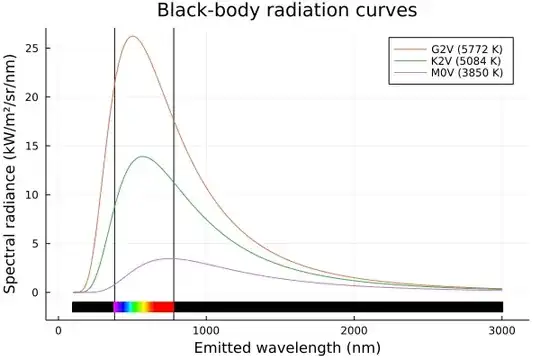I'm designing an alien world in which plantlife is mostly red. I've read that the type of star the planet orbits plays an important role to the plants' color (For example, worlds around M type stars are more likely to have black plants to absord more sunlight). My world is pretty similar to Earth in terms of gravity, atmosphere and chemical composition. So what kind of star do i need to use to for red plant life to be dominant?
-
1Technically we here on Earth have some red-pigmented plants, so extrapolating, a star that would be "more red" (cooler) could just do. Exact values depend on whether chlorophyll-involved photosynthesis would be less productive than one with red catalyst, this would require some serious scientific data which isn't available for me right now. – Vesper Jul 28 '22 at 10:39
-
3Our star allows for red photosynthetic life. And cyan photosynthetic life. And yellow-brown photosynthetic life. In addition to green photosynthetic life. That land plants are mostly green is an accident; they are green because they descend from green algae; it is not an advantage, it is not a disadvantage. The sun provides vastly more energy than photosynthetic organisms can use. – AlexP Jul 28 '22 at 12:19
-
It isn't just the star. In fact (not being a botanist) I'd wager the star type has the lowest effect on getting red plants. Here on Earth we have plenty of plants with red stems and plants with read leaves and plants with red petals. You'd be more successful, I believe, asking what could replace chlorophyll that would reflect red rather than green. (Assuming that hasn't already been asked.) – JBH Jul 28 '22 at 15:29
1 Answers
To continue from my last post on this subject, if you want red plants, then you probably want to have a star that emits plenty of light in shorter wavelengths. If most of the emitted energy is red or near-IR, then you want to be absorbing that light and not reflecting it, which means you probably won't be reddish (or near-IR colored, which complex life in such an environment is likely to be able to distinguish).
Plants aren't often red-colored on Earth, because using chlorophyll is pretty popular and chlorophyll absorbs blue and red light, reflecting the unused green. That doesn't have to be the case, though. Have a look at this graph of the absorption spectra of some terrestrial photosynthetic pigments:
(original source at plantphys.info no longer exists, haven't found a new source)
There already exist a number of photosynthetic pigments and accessory pigments that don't absorb red light, and give us things that are carrot-orange and tomato-red. All you have to do is to handwave in either a) the absence of chlorophyll (and all its relatives like bacteriochlorophyll) or b) the existence of an alternative dominant photopigment that's approximately as efficient and effective as chlorophyll, ensuring that even if green stuff does exist, most stuff isn't green. The space of chemicals that could absorb a photon and cough up an electron is vast, and by no means thoroughly explored by either nature or science. You have free rein to just make something up, and it'll be plausible enough, which is nice.
Then all you need to do is to provide plenty of blue, green and yellow light.
Here we have the emission spectra of black bodies of temperatures corresponding to a G2V star (such as the Sun), a K2V star (such as Epsilon Eridani) and an M0V star (such as Lacaille 8760, though that star's a bit hotter and brighter than the example in the chart)
The area under the graph is roughly equivalent to the proportion of the energy radiated from the star. You can see that the Sunlike star emits lots of energy all across the visible spectrum (which is crudely marked, and corresponds to the 380nm to 780nm band), but the M0V red dwarf emits lots of red and IR, but not nearly so much shorter wavelength stuff.
I'd say that anything between a moderately warm K-class orange star, and a G-class (or maybe a cool F-class) star should give you all the short wavelength light you need for red-reflecting photosynthesizers to do just fine.
- 74,426
- 11
- 150
- 313
-
Huh, so the proper answer would be not red star but blue? Still a question - if the star would emit enough green spectrum to fulfill energy requirements for lycopene-based plants but not enough blue light to fulfilll chlorophyll-2-based plants, will red plants be more likely to dominate than green plants? Say a K5-K7 star with temp around 4300-4500K could provide enough green but not enough blue. And IIRC red light isn't strong enough to trigger photosynthesis alone, so maybe a planet around M0-star could not even support any photosynthetic life. – Vesper Jul 28 '22 at 14:33
-
@Vesper if you had the right kind of pigment arise suitably early in the evolutionary history of photosynthesizers, the star could be anything other than cool orange/red. Its just about having enough non-red light, and there being no other substantially more effective photosynthesizers to compete with. If you snapped your fingers and replaced chlorophyll with something else as good a few billion years ago, terrestrial vegetation could be non-green. – Starfish Prime Jul 28 '22 at 14:38

